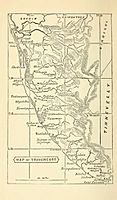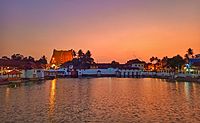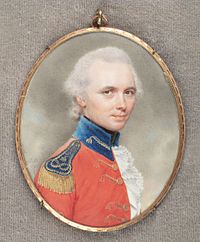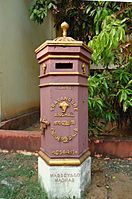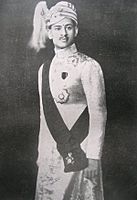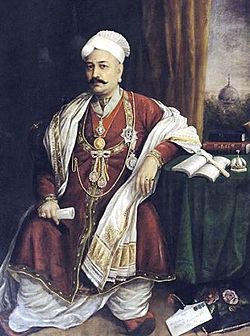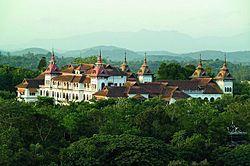Travancore facts for kids
Quick facts for kids
Kingdom of Thiruvithamkoor
തിരുവിതാംകൂർ
|
|||||||||
|---|---|---|---|---|---|---|---|---|---|
| 1729–1949 | |||||||||
|
Motto: Dharmōsmat Kuladaivatam (धर्मोस्मत् कुलदैवतम्, ധർമോസ്മൽ കുലദൈവതം) (Charity is our household divinity)
|
|||||||||
|
Anthem: Vanchishamangalam (Victory to the Lord of Vanchi)
|
|||||||||
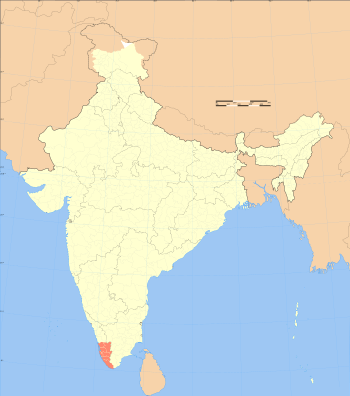
Kingdom of Travancore in India
|
|||||||||
| Status | Princely State of British Empire | ||||||||
| Capital | Padmanabhapuram (1729–1795) Trivandrum (1795–1949) |
||||||||
| Common languages | Malayalam, Tamil | ||||||||
| Religion | Majority:Hinduism (official) Minority: Chiefly Christianity and Islam Small communities of Jews, Sikhs and Zoroastrians |
||||||||
| Government | Monarchy | ||||||||
| Maharaja | |||||||||
|
• 1729–1758 (first)
|
Marthanda Varma | ||||||||
|
• 1829–1846 (peak)
|
Swathi Thirunal | ||||||||
|
• 1931–1949 (last)
|
Chithira Thirunal | ||||||||
| Resident | |||||||||
|
• 1788–1800 (first)
|
George Powney | ||||||||
|
• 1800–1810
|
Colin Macaulay | ||||||||
|
• 1840–1860 (peak)
|
William Cullen | ||||||||
|
• 1947 (last)
|
Cosmo Grant Niven Edwards | ||||||||
| Historical era | Age of Imperialism | ||||||||
|
• Established
|
1729 | ||||||||
|
• Vassal of British Empire
|
1795 | ||||||||
|
• Vassal of India
|
1947 | ||||||||
|
• Disestablished
|
1949 | ||||||||
| Area | |||||||||
| 1941 | 19,844 km2 (7,662 sq mi) | ||||||||
| Population | |||||||||
|
• 1941
|
6,070,018 | ||||||||
| Currency | Travancore rupee | ||||||||
|
|||||||||
| Today part of | India | ||||||||
The Kingdom of Travancore was an important Indian kingdom that existed from about 1729 until 1949. It was also known as the Kingdom of Thiruvithamkoor. The Travancore Royal Family ruled this kingdom. Their first capital was Padmanabhapuram, and later they moved it to Thiruvananthapuram.
At its largest, Travancore covered most of southern Kerala today. This included districts like Idukki, Kottayam, and Thiruvananthapuram. It also included the southernmost part of Tamil Nadu, like Kanyakumari district. However, some small areas like Tangasseri and Anchuthengu were British colonies.
The official flag of Travancore was red. It had a silver conch shell in the middle. The kingdom's coat of arms showed two elephants guarding a conch shell. Travancore was bordered by the Kingdom of Cochin to the north and the Indian Ocean to the south. The Arabian Sea was to its west.
King Marthanda Varma took over the small state of Venad in 1723. He built it into Travancore, making it one of the strongest kingdoms in southern India. Marthanda Varma led Travancore's army in the Travancore-Dutch War (1739–46). This war ended with the Battle of Colachel, where Travancore defeated the Dutch. This victory was special because it was one of the first times an Asian power beat a European army using their own military methods.
In the early 1800s, Travancore became a princely state under the British Empire. The Travancore government made many good changes. During the rule of Maharaja Sri Chithira Thirunal Balarama Varma, Travancore became a modern and successful state. It was known for its achievements in education, government, public works, and social improvements. In 1903–1904, the state's total income was over 10 million rupees.
Contents
What's in a Name?
The kingdom got its name from Thiruvithamcode. This place is now in the Kanyakumari district of Tamil Nadu.
This area used to have many small, independent kingdoms. Later, it became part of the Chera Kingdom. Even then, it was known as Thiruvazhumkode. Over time, this name became Thiruvankode. The English then changed it to Travancore.
The Ay kingdom was part of the Chera empire. It ruled the Thiruvazhumkode area. Eventually, the Ay kingdom became independent. Its land was called Aayi Desam. The Aayis controlled a large area from Kollam in the north to Kanyakumari. They had two capitals. The main one was at Kollam, and a smaller one was at Thrippapur. So, the kingdom was also called Venad.
The Chera empire ended around 1100. After that, the region had many small kingdoms. This changed when Marthanda Varma became king of Venad in 1729. He used strong methods to unite these small kingdoms. During his rule, Thiruvithamcode, or Travancore, became the official name.
Where Was Travancore?
The Kingdom of Travancore was located at the very southern tip of India. It had three main regions based on climate. These were the eastern highlands with cool mountains. Then there were the central midlands with rolling hills. Finally, the western lowlands were coastal plains.
A Look at History
The Ay Dynasty
The history of central and southern Travancore was quite different from the rest of Kerala. The Chera dynasty ruled the Malabar Coast further north. But the southern part of present-day Kerala was under the Ay dynasty. The Ay rulers were more connected to the Pandya dynasty of Madurai.
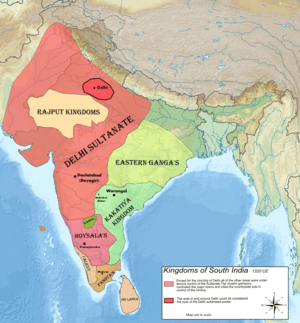
The Ay dynasty ruled the areas of present-day Thiruvananthapuram and Kanyakumari. They were Tamil-speaking rulers. The Ay kingdom faced attacks from the Cholas and Pandyas. Later, it became part of Venad. This Venad kingdom then grew into Travancore in the 1700s. The Padmanabhaswamy temple shows a Tamil-Dravidian style of building. This makes it different from temples in northern Kerala.
Southern Kerala was ruled by Tamil dynasties for a long time. These included the Ay, Pandya, and Chola dynasties. This lasted until the 16th and 17th centuries. The official language of Venad, based in Kollam, was also Tamil. Even today, place names and customs in southern Kerala show a strong Tamil influence. Malayalam became more common when Venad expanded into Travancore.
The Venad Kingdom
The state of Venad was at the tip of India. It was traditionally ruled by kings called Venattadis. Until the late 1000s AD, it was a small part of the Ay Kingdom. The Ays were the first rulers in southern Kerala. At their strongest, they ruled from Nagercoil to Thiruvananthapuram. Their capital was at Kollam.
Attacks by the Pandyas caused the Ay dynasty to decline. But they were still powerful until the early 900s. A Persian merchant named Sulaiman al-Tajir visited Kerala in the 800s. He wrote that there was a lot of trade between Kerala and China. This trade happened through the port of Kollam.
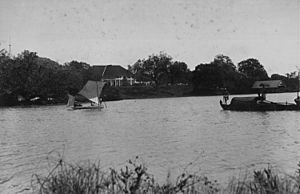
When the Ay dynasty weakened, Venad became the southernmost part of the Second Chera Kingdom. An invasion by the Cholas destroyed Kollam in 1096. The Chera capital also fell. This made the Chera king, Rama Varma Kulasekara, move his capital to Kollam. He was likely the founder of the Venad royal family. The rulers of Venad then used the title Kulasekara. So, the end of the Second Chera dynasty in the 1100s meant Venad became independent.
In the late 1100s, two branches of the Ay dynasty joined the Venad family. This led to a tradition. The ruler of Venad was called Chirava Moopan. The next in line to the throne was called Thrippappur Moopan. The Chirava Moopan lived in Kollam. The Thrippappur Moopan lived in Thrippappur. He was in charge of the temples in Venad, especially the Sri Padmanabhaswamy temple.
Mysore Attacks Travancore
Marthanda Varma's successor was Karthika Thirunal Rama Varma (1758–1798). He was known as Dharma Raja. In 1795, he moved the capital from Padmanabhapuram to Thiruvananthapuram. Dharma Raja's time is seen as a Golden Age for Travancore. He kept the land his predecessor had gained. He also worked to improve society. He had a very good helper, Raja Kesavadas, who was the Diwan of Travancore.

Travancore often worked with the English East India Company in wars. During Dharma Raja's rule, Tipu Sultan attacked Travancore in 1789. Tipu Sultan was the ruler of Mysore. Dharma Raja had refused to hand over Hindu refugees from Mysore. These refugees had found safety in Travancore. Tipu Sultan's army entered the Cochin kingdom in November 1789. They reached Thrissur in December. On December 28, 1789, Tipu Sultan attacked the Nedunkotta (Northern Lines). This led to the Battle of the Nedumkotta (1789). The Mysore army was defeated.
Velu Thampi Dalawa's Fight
After Dharma Raja died in 1798, Balarama Varma (1798–1810) became ruler. He was only sixteen. A treaty in 1795 put Travancore under the protection of the East India Company.
The Prime Ministers, called Dalawas or Dewans, started to control the kingdom. Velu Thampi Dalawa (1799–1809) was appointed as the divan. At first, Velayudhan Chempakaraman Thampi got along well with the English East India Company. In 1805, some of the Travancore army rebelled against Velu Thampi Dalawa. He asked for help from the British Resident, Colonel Colin Macaulay. He used the East India Company's troops to stop the rebellion.
Velu Thampi also helped make a new treaty between Travancore and the East India Company. However, the East India Company demanded money. They wanted payment for helping Travancore in the war against Mysore. This caused problems between the Diwan and Colonel Macaulay. Velu Thampi and the diwan of Cochin, Paliath Achan, declared war on the East India Company.
The East India Company army defeated Paliath Achan's army in Cochin in 1809. Paliath Achan surrendered and was sent away. The Company also defeated Velu Thampi Dalawa's forces. These battles happened near Nagercoil and Kollam. Many rebels left the army and went home. The Maharajah of Travancore then joined the British. He appointed one of Thampi's enemies as his prime minister. The combined British and Travancore armies camped near Thiruvananthapuram. Velu Thampi Dalawa then started a guerrilla fight. But he died soon after. After these events, most of Travancore's army was disbanded. The East India Company agreed to protect the Rajah from outside and inside threats.
Ending Costly Rituals
The Rajahs of Travancore used to perform 16 mahādānams. These were great gifts given in charity. Thousands of Brahmins received expensive gifts, including gold. In 1848, the Marquess of Dalhousie, who was the Governor-General of India, learned about this. He was told that these mahādānams were making Travancore's finances weak.
Lord Dalhousie told Lord Harris, the Governor of Madras, to warn the King of Travancore. The king was Martanda Varma (1847–60). He was told that if he did not stop these practices, Madras would take over his state's government. This led to the end of the mahādānams.
All Travancore kings, including Sree Moolam Thirunal, had performed these ceremonies. Maharaja Chithira Thirunal was the only king not to do them. He thought they were too expensive.
The 19th and Early 20th Centuries
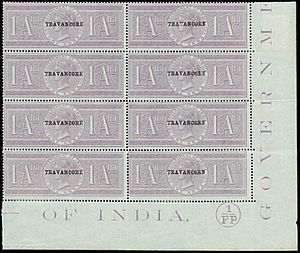
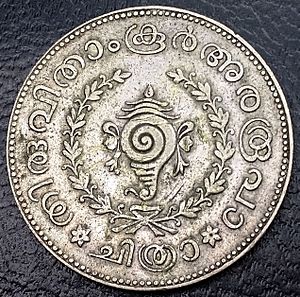
In Travancore, the caste system was very strict until the mid-1800s. This system divided people into social groups. The government supported this system. It made the caste system a religious rule. The Ayyavazhi faith helped people who were treated unfairly. It was a religious system and a reform movement. Its practices helped the Ayyavazhi group deal with and resist authority.
Vaikundar spoke strongly against the system. King Swathi Thirunal Rama Varma first put Vaikundar in jail. But the jailor became Vaikundar's follower. Later, the King set Vaikundar free.
After Sree Moolam Thirunal died in 1924, Sethu Lakshmi Bayi became regent (1924–1931). This was because the next king, Sree Chithira Thirunal, was only 12 years old.
In 1935, Travancore joined the Indian State Forces Scheme. A Travancore unit was called the 1st Travancore Nair Infantry. This unit was reorganized by Lieutenant Colonel H S Steward.
The last king of Travancore was Chithira Thirunal Balarama Varma. He ruled from 1931 to 1949. His rule brought huge progress in education, defense, economy, and society. On November 12, 1936, he made the famous Temple Entry Proclamation. This opened all Hindu temples in Travancore to all Hindus. Before this, only upper-caste Hindus could enter. This act was praised across India, especially by Mahatma Gandhi.
During his rule, the first public transport system was started. A telecommunication system was also launched. He began to industrialize the state. He set up large public companies. About twenty industries were created. Most of these used local materials like rubber and minerals. Many of Kerala's main industries today were started by Sree Chithira Thirunal. He also supported musicians, artists, and scholars. He even created a new type of university training group called the Labour Corps. The government paid for all university expenses. Sree Chithira Thirunal also built the beautiful Kowdiar Palace.
However, his prime minister, Sir C. P. Ramaswami Iyer, was not popular with the communists in Travancore. This caused some small riots. In one riot in Punnapra-Vayalar in 1946, communist rioters set up their own government. The Travancore Army and Navy stopped this.
In June 1947, the prime minister said Travancore would stay independent. It would not join the Indian Union. After this, someone tried to attack him. He then resigned and left for Madras. Sri P.G.N. Unnithan took his place. The king, Sree Chithira Thirunal, later agreed that the Kingdom should join the Indian Union in 1949. On July 1, 1949, Travancore merged with the Kingdom of Cochin. They formed the state of Travancore-Kochi.

Sree Chithira Thirunal died on July 20, 1991. He had ruled Travancore for 67 years. He was one of the last rulers of a major princely state from the old British Raj. His brother, Uthradom Thirunal Marthanda Varma, became the head of the Royal House. The Government of India released a stamp in 1991. It honored the changes made during his rule in Travancore.
How Kerala Was Formed
The state of Kerala was created on November 1, 1956. A governor, appointed by the president of India, became the head of state instead of a king. The king lost all his political powers. He also lost the right to receive special payments. This happened because of a change to the Indian constitution in 1971.
Kanyakumari Joins Madras State
Many Tamils lived in certain areas of Travancore. These included Thovalai, Agastheeswaram, and Sengottai. Malayalam was the official language there. There were only a few Tamil schools. So, Tamils faced many difficulties. The Travancore government kept refusing their requests.
At that time, the Travancore State Congress wanted to unite all Malayalam-speaking regions. They wanted to form a "Unified Kerala." Many Tamil leaders left the party because of this idea. Tamils gathered in Nagercoil on December 16, 1945. They formed a new political party called the All Travancore Tamilian Congress. This party wanted the Tamil regions in Travancore to join Tamil Nadu.
During election campaigns, there were conflicts between Tamil and Malayali communities. Police stopped the protesting Tamils. In February 1948, police opened fire. Two Tamil-speaking people were killed.
The Tamilian Congress changed its name to Travancore Tamil Nadu Congress (T.T.N.C) in 1946. T.T.N.C was popular among Tamils in certain areas. Ma. Po. Sivagnanam was the only leader from Tamil Nadu who supported T.T.N.C. After India became independent, state elections were announced in Travancore. T.T.N.C became more popular among Tamils.
A popular lawyer from Vilavancode, A. Nesamony, organized a meeting in Nagercoil in 1947. At this meeting, they decided to achieve their goal through T.T.N.C. The T.T.N.C then grew stronger.
T.T.N.C won 14 seats in the State Legislative Assembly election. Mr. A. Nesamony became the party's leader in the assembly. Under his leadership, the Tamil people were ready to make sacrifices for their goal.
In 1950, a meeting was held to find a compromise between the state congress and T.T.N.C. The meeting failed. Mr. Sam Nathaniel resigned as president of T.T.N.C. Mr. P. Ramasamy Pillai became the new president. In the 1952 general election, T.T.N.C won 8 assembly seats. Mr. A. Chidambaranathan became a minister in the government. Mr. A. Nesamony was elected as a Member of Parliament.
Later, T.T.N.C left the government. They said the Congress government was not helping the Tamils enough. The Congress government lost its majority. So, new elections were called. In the 1954 elections, T.T.N.C won 12 seats.
Pattom A. Thanu Pillai was the chief minister. He took strong actions against the Tamil protests. Tamils in the Devikulam and Peermedu regions faced harsh treatment from the police. T.T.N.C leaders from Nagercoil protested against these orders. The leaders were arrested. This caused unrest in South Travancore.
On August 11, Liberation Day celebrations were held. Public meetings and marches took place. Communists also joined the protests. Police opened fire on marches in Thoduvetty and Puthukadai. Nine Tamil volunteers were killed. Thousands of T.T.N.C and communist supporters were arrested. Eventually, Pattom Thanu Pillai's government fell. Things returned to normal in the Tamil regions.
The central government set up the Fazal Ali Commission in 1953. This commission was for reorganizing states based on language. Its report was submitted in 1955. Based on this report, Devikulam and Peermedu Taluks joined Kerala. On November 1, 1956, four Taluks—Thovalai, Agastheeswaram, Kalkulam, and Vilavancode—formed the new Kanyakumari District. This district joined Tamil Nadu. Half of Sengottai Taluk joined Tirunelveli District. The main goal of T.T.N.C was to merge Tamil regions with Tamil Nadu. Most of their demand was met. So, T.T.N.C was then dissolved.
Devikulam and Peerumedu Stay in Kerala
Besides Kanyakumari district, the Taluks of Devikulam and Peermade also had a Tamil-speaking majority until the late 1940s. The T.T.N.C had asked for these Taluks to join Madras State. However, they stayed in Kerala because of decisions made by Pattom Thanu Pillai. He was the first prime minister of Travancore.
Pattom started a project to change the population in the Cardamom Hills. His plan was to move 8,000 Malayalam-speaking families into Devikulam and Peermade. About 50,000 acres in these Taluks, which were mostly Tamil-speaking, were chosen for this project. This project helped these two Taluks and a large part of the Cardamom Hills stay in Kerala. This happened after the States Reorganisation Act, 1956.
How Travancore Was Governed
The king directly controlled Travancore's government. A Dewan was the head of administration. He was helped by a secretary, an assistant secretary, and many clerks and accountants. Individual districts were managed by Sarvadhikaris. They worked under the Diwan's supervision. A Valia Sarvahi handled dealings with neighboring states and Europeans. He signed treaties and agreements.
Kings of Travancore
- Anizham Tirunal Marthanda Varma (1729–1758)
- Karthika Thirunal Rama Varma (Dharma Raja) (1758–1798)
- Balarama Varma I (1798–1810)
- Gowri Lakshmi Bayi (Queen from 1810 to 1813 and Regent Queen from 1813 to 1815)
- Gowri Parvati Bayi (Regent) (1815–1829)
- Swathi Thirunal Rama Varma II (1813–1846)
- Uthram Thirunal Marthanda Varma II (1846–1860)
- Ayilyam Thirunal Rama Varma III (1860–1880)
- Visakham Thirunal Rama Varma IV (1880–1885)
- Sree Moolam Thirunal Rama Varma VI (1885–1924)
- Sethu Lakshmi Bayi (Regent) (1924–1931)
- Chithira Thirunal Balarama Varma II (1924–1949)
Prime Ministers of Travancore
Dalawas
- Arumukham Pillai (1729–1736)
- Thanu Pillai (1736–1737)
- Ramayyan Dalawa (1737–1756)
- Martanda Pillai (1756–1763)
- Warkala Subbayyan (1763–1768)
- Krishna Gopalayyan (1768–1776)
- Vadiswaran Subbrahmanya Iyer (1776–1780)
- Mullen Chempakaraman Pillai (1780–1782)
- Nagercoil Ramayyan (1782–1788)
- Krishnan Chempakaraman (1788–1789)
- Raja Kesavadas (1789–1798)
- Odiery Jayanthan Sankaran Nampoothiri (1798–1799)
- Velu Thampi Dalawa (1799–1809)
- Oommini Thampi (1809–1811)
Dewans
- Col. John Munro (1811–1814)
- Devan Padmanabhan Menon (1814–1814)
- Bappu Rao (acting) (1814–1815)
- Sanku Annavi Pillai (1815–1815)
- Raman Menon (1815–1817)
- Reddy Row (1817–1821)
- T. Venkata Rao (1821–1830)
- Thanjavur Subha Rao (1830–1837)
- T. Ranga Rao (acting) (1837–1838)
- T. Venkata Rao (Again) (1838–1839)
- Thanjavur Subha Rao (again) (1839–1842)
- Krishna Rao (acting) (1842–1843)
- Reddy Row (again) (1843–1845)
- Srinivasa Rao (acting) (1845–1846)
- Krishna Rao (1846–1858)
| Name | Portrait | Took office | Left office | Term |
|---|---|---|---|---|
| T. Madhava Rao |  |
1857 | 1872 | 1 |
| A. Seshayya Sastri |  |
1872 | 1877 | 1 |
| Nanoo Pillai | 1877 | 1880 | 1 | |
| V. Ramiengar |  |
1880 | 1887 | 1 |
| T. Rama Rao |  |
1887 | 1892 | 1 |
| S. Shungrasoobyer | 1892 | 1898 | 1 | |
| V. Nagam Aiya |  |
1901 | 1904 | 1 |
| K. Krishnaswamy Rao |  |
1898 | 1904 | 1 |
| V. P. Madhava Rao |  |
1904 | 1906 | 1 |
| S. Gopalachari | 1906 | 1907 | 1 | |
| P. Rajagopalachari | 1907 | 1914 | 1 | |
| M. Krishnan Nair | 1914 | 1920 | 1 | |
| T. Raghavaiah | 1920 | 1925 | 1 | |
| M. E. Watts | 1925 | 1929 | 1 | |
| V. S. Subramanya Iyer | 1929 | 1932 | 1 | |
| T. Austin | 1932 | 1934 | 1 | |
| Sir Muhammad Habibullah |  |
1934 | 1936 | 1 |
| Sir C. P. Ramaswami Iyer |  |
1936 | 1947 | 1 |
| P.G.N.Unnithan | 1947 | 1947 | 1 |
Prime Ministers of Travancore (1948-49)
| No. | Name | Portrait | Term of office (tenure length) |
Assembly (election) |
Appointed by
(Monarch) |
||||
|---|---|---|---|---|---|---|---|---|---|
| From | To | Days in office | |||||||
| 1 | Pattom A. Thanu Pillai |  |
24 March 1948 | 17 October 1948 | 210 days | Indian National Congress | Representative
Body (1948–49) |
Sir Chithira Thirunal Balarama Varma, Maharaja of Travancore | |
| 2 | Paravoor T. K. Narayana Pillai | 22 October 1948 | 1 July 1949 | 253 days | |||||
Areas of Travancore
In 1856, the princely state was divided into three main areas. Each area was managed by a Divan Peishkar. This person had a rank similar to a District Collector in British India. These divisions were:
- The Northern (Cottayam) area.
- The Quilon (Central) area.
- The Southern (Padmanabhapuram) area.
Divisions in 1911
The 1911 Census Report of Travancore described five divisions:
1. Padmanabhapuram Division
This was the original home of Travancore. It included Thiruvithamcode and Padmanabhapuram. Most people in this division were Tamils. This area is now the Kanyakumari district in Tamil Nadu. The report also said that the two southernmost parts of this division looked more like the Tamil country than the rest of Malayalam country.
2. Trivandrum Division
This was the main headquarters of Travancore from 1795. The Neyyattinkara area was a major industrial center. This division also had many Tamils, especially in the southern parts. The Trivandrum Division is now the Thiruvananthapuram district.
3. Quilon Division
Quilon was the capital of Venad. It was the largest port in Travancore. It was also one of the oldest ports on the Malabar Coast. The 1911 Census said that the true Malayalam country began from the Quilon division. However, the Sengottai area of this division was mostly Tamil-speaking. Geographically, Sengottai looked more like Madurai and the Tamil country.
4. Kottayam Division
This division was in the northernmost part of Travancore. It was a purely Malayalam-speaking area. The Vembanad Lake was a special feature of this division.
5. Devikulam Division
This division included most of the present-day Idukki district. It was also connected to the Tamil regions. The Devikulam division was a Tamil-speaking area.
People of Travancore
Religion in Travancore (1941) Hinduism (60.49%) Islam (7.15%) Christianity (32.35%)
Travancore had a population of 6,070,018 people in 1941.
Religions in Travancore
| Census year | Total population | Hindus | Christians | Muslims | |||
|---|---|---|---|---|---|---|---|
| 1816 – 1820 | 906,587 | 752,371 | 82.99% | 112,158 | 12.37% | 42,058 | 4.64% |
| 1881 | 2,401,158 | 1,755,610 | 73.12% | 498,542 | 20.76% | 146,909 | 6.12% |
| 1891 | 2,557,736 | 1,871,864 | 73.18% | 526,911 | 20.60% | 158,823 | 6.21% |
| 1901 | 2,952,157 | 2,063,798 | 69.91% | 697,387 | 23.62% | 190,566 | 6.46% |
| 1911 | 3,428,975 | 2,298,390 | 67.03% | 903,868 | 26.36% | 226,617 | 6.61% |
| 1921 | 4,006,062 | 2,562,301 | 63.96% | 1,172,934 | 29.27% | 270,478 | 6.75% |
| 1931 | 5,095,973 | 3,137,795 | 61.57% | 1,604,475 | 31.46% | 353,274 | 6.93% |
| 1941 | 6,070,018 | 3,671,480 | 60.49% | 1,963,808 | 32.35% | 434,150 | 7.15% |
Languages Spoken
| Census year | Total population | Malayalam | Tamil | Others | |||
|---|---|---|---|---|---|---|---|
| 1875 | 2,311,379 | 1,902,533 | 82.32% | 387,909 | 16.78% | 20,937 | 0.91% |
| 1881 | 2,401,158 | 1,937,454 | 80.69% | 439,565 | 18.31% | 24,139 | 1.01% |
| 1891 | 2,557,736 | 2,079,271 | 81.29% | 448,322 | 17.53% | 30,143 | 1.18% |
| 1901 | 2,952,157 | 2,420,049 | 81.98% | 492,273 | 16.68% | 39,835 | 1.35% |
| 1911 | 3,428,975 | 2,836,728 | 82.73% | 554,618 | 16.17% | 37,629 | 1.10% |
| 1921 | 4,006,062 | 3,349,776 | 83.62% | 624,917 | 15.60% | 31,369 | 0.78% |
| 1931 | 5,095,973 | 4,260,860 | 83.61% | 788,455 | 15.47% | 46,658 | 0.92% |
| Name of Division | Malayalam (%) | Tamil (%) |
| Padmanabhapuram Division | 11.24 | 88.03 |
|---|---|---|
| Trivandrum Division | 87.05 | 12.09 |
| Quilon Division | 92.42 | 6.55 |
| Cottayam Division | 95.19 | 3.65 |
| Devicolam Division | 36.18 | 59.14 |
| Name of Taluk | Total population | Malayalam | Tamil | Others | ||||
| 1 | Thovalai | 30,260 | 190 | 0.63% | 29,708 | 98.18% | 362 | 1.20% |
|---|---|---|---|---|---|---|---|---|
| 2 | Agasteeswaram | 78,979 | 705 | 0.89% | 76,645 | 97.04% | 1,629 | 2.06% |
| 3 | Eraniel | 112,116 | 9,640 | 8.60% | 102,389 | 91.32% | 87 | 0.08% |
| 4 | Culcoolum | 60,908 | 10,528 | 17.29% | 49,930 | 81.98% | 450 | 0.74% |
| 5 | Vilavancode | 69,688 | 18,497 | 26.54% | 51,172 | 73.43% | 19 | 0.03% |
| 6 | Neyyattinkarai | 110,410 | 97,485 | 88.29% | 12,809 | 11.60% | 116 | 0.11% |
| 7 | Trivandrum South | 51,337 | 39,711 | 77.35% | 10,522 | 20.50% | 1,104 | 2.15% |
| 8 | Trivandrum North | 51,649 | 38,979 | 75.47% | 11,102 | 21.50% | 1,568 | 3.04% |
| 9 | Nedoomangad | 52,211 | 48,492 | 92.88% | 3,573 | 6.84% | 146 | 0.28% |
| 10 | Sheraingil | 87,072 | 82,339 | 94.56% | 4,629 | 5.37% | 146 | 0.17% |
| 11 | Kottarakkarai | 55,924 | 51,836 | 94.56% | 3,994 | 7.14% | 94 | 0.17% |
| 12 | Pathanapuram | 37,064 | 35,264 | 95.14% | 1,603 | 4.32% | 197 | 0.53% |
| 13 | Sengottai | 30,477 | 7 | 0.02% | 29,694 | 97.43% | 776 | 2.55% |
| 14 | Quilon | 108,469 | 103,775 | 95.67% | 3,650 | 3.37% | 1,044 | 0.96% |
| 15 | Kunnathur | 62,700 | 60,330 | 96.22% | 2,339 | 3.73% | 31 | 0.05% |
| 16 | Karunagapully | 101,039 | 99,079 | 98.06% | 1,814 | 1.80% | 146 | 0.14% |
| 17 | Karthikapully | 81,969 | 79,705 | 97.24% | 1,059 | 1.29% | 1,205 | 1.47% |
| 18 | Mavelikkarai | 111,731 | 107,404 | 96.13% | 4,139 | 3.70% | 188 | 0.17% |
| 19 | Chengannur | 81,301 | 80,295 | 98.76% | 986 | 1.21% | 20 | 0.02% |
| 20 | Thiruvallai | 103,007 | 101,041 | 98.09% | 1,664 | 1.62% | 302 | 0.29% |
| 21 | Ambalappulay | 93,401 | 82,345 | 88.16% | 5,864 | 6.28% | 5,192 | 5.56% |
| 22 | Sharetala | 113,704 | 107,108 | 94.20% | 2,312 | 2.03% | 4,284 | 3.77% |
| 23 | Vycome | 76,414 | 72,827 | 95.31% | 2,684 | 3.51% | 903 | 1.81% |
| 24 | Yettoomanoor | 79,058 | 75,004 | 94.87% | 3,879 | 4.91% | 175 | 0.22% |
| 25 | Cottayam | 64,958 | 63,831 | 98.27% | 722 | 1.11% | 405 | 0.62% |
| 26 | Chunganacherry | 74,154 | 66,481 | 89.65% | 7,394 | 9.97% | 279 | 0.38% |
| 27 | Meenachel | 57,102 | 55,186 | 96.64% | 1,857 | 3.25% | 59 | 0.10% |
| 28 | Moovattupulay | 95,460 | 93,473 | 97.92% | 1,930 | 2.02% | 57 | 0.06% |
| 29 | Todupulay | 24,321 | 23,227 | 95.50% | 1,085 | 4.46% | 9 | 0.04% |
| 30 | Cunnathunad | 109,625 | 108,083 | 98.59% | 831 | 0.76% | 711 | 0.65% |
| 31 | Alangaud | 66,753 | 65,839 | 98.63% | 571 | 0.86% | 343 | 0.51% |
| 32 | Paravoor | 61,966 | 56,495 | 91.17% | 3,332 | 5.38% | 2,139 | 3.45% |
| 33 | Cardamom Hills | 6,228 | 2,253 | 36.18% | 3,683 | 59.14% | 292 | 4.69% |
| - | Travancore | 2,401,158 | 1,937,454 | 80.69% | 439,565 | 18.31% | 24,139 | 1.01% |
Culture and Society
The rulers of Travancore were generally well-liked by their people. Unlike some other kings in India, they spent only a small part of the state's money on themselves. They used most of the state's income to benefit the public. This made them very popular with their subjects.
However, like many places in British India, there were disagreements and conflicts based on social groups or beliefs in Travancore. Some people felt there was a lot of unfair treatment based on social groups. For example, Tamil Brahmins and Nairs held most government jobs until the 1900s.
The Travancore royal family were very religious Hindus. Some kings followed certain social rules. For instance, it was reported that Maharaja Visakham Thirunal had to take a bath after touching a European visitor's wife in 1880. This was to remove what was considered ritual impurity. The strict social system began to change in the late 1800s. This was due to several reform movements. As a result, Travancore became the region with the highest male literacy rate in India.
Unlike most of India, women in higher social groups in Travancore had more social status and freedom. However, the Upper cloth revolt in the 1800s shows this was not true for all women. Women from lower social groups were not allowed to wear upper body clothing in Travancore. In some communities, daughters could inherit property. They were educated and had the right to divorce and remarry. But after 1925, laws were changed by Regent Queen Sethu Lakshmi Bayi. These laws made women's rights regarding property and family matters more limited.
Images for kids
See also
 In Spanish: Travancore para niños
In Spanish: Travancore para niños




